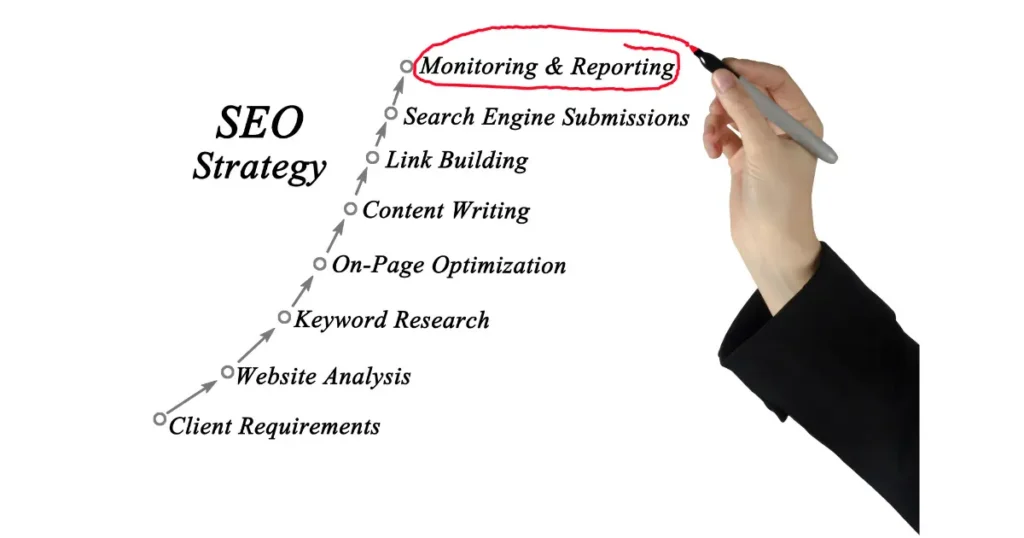
If you run a fintech business and your website isn’t showing up on Google, you’re leaving serious money on the table.
We are now in a world where consumers Google before they trust. SEO (Search Engine Optimization) is your fintech startup’s golden ticket to organic growth; no need to burn through paid ads every month. With a smart SEO strategy, you can attract the right customers, build trust, and scale all without going broke.
So, what does SEO for fintech really involve? And how can you start getting organic customers?
Let’s break it down in a simple, friendly, and actionable way.
What Is SEO for Fintech?
SEO for fintech is all about optimizing your digital presence (mainly your website and blog) so your target customers can find you on search engines like Google when they’re searching for solutions you offer.
Let’s say you run a digital lending platform in Nigeria. Wouldn’t it be amazing if your website popped up when someone types “best loan apps in Nigeria” or “how to get instant loans online”?
That’s the power of SEO.
Why SEO Matters for Fintech
Before we go into specific SEO strategies for your fintech business, let’s talk about why SEO is actually worth your time, especially if you’re serious about attracting and keeping the right customers.
- Builds brand awareness and trust: When your business shows up consistently in search results, people start to recognize and trust your brand more. That visibility does more than just get clicks, it builds credibility.
- Drives more (and better) traffic: Good SEO brings in organic traffic from people who are already searching for what you offer. That means more opportunities to turn visitors into paying customers.
- Boosts conversions: A well-optimized website doesn’t just look good, it works better. It guides visitors smoothly from interest to action, which means more signups, sales, or leads for you.
- Creates a smoother user experience: SEO isn’t just about keywords. It’s also about improving your site’s structure and content so visitors can easily find what they need—and actually enjoy using your site.
- Keeps you ahead of the curve: The fintech space is competitive. SEO helps you stay on top of industry trends, search engine updates, and your competitors, so you’re not left behind.
The Challenges You Can Expect
Fintech and SEO are closely intertwined, as fintech companies are primarily internet-based. This is why fintech companies must ensure they have effective SEO strategies to enhance their marketing efforts.

Due to the huge effect that even one SEO strategy can have on an online business, Fintech companies need to use these methods. However, not everyone is familiar with SEO or knows how to employ effective tactics.
So let’s look at eight SEO strategies that any Fintech company can use to their advantage and see how well they work.
8 Fintech SEO Strategies to Drive Traffic and Conversions
Here are eight practical strategies your fintech marketing team can start using to boost your search rankings, drive more traffic to your site, and strengthen your online presence.

1. Start with a Strong SEO Foundation
The first step in getting SEO right for your fintech business is building a solid foundation. It’s the groundwork that determines how well you’ll rank online. Whether you’re just getting started or already have a few things in place, it’s always a smart move to pause and make sure your digital presence is built on something strong and sustainable.
Having solid groundwork in fintech means having the essentials in place for your brand identity (like your messaging and visuals), a website that can grow with you, and content that speaks directly to your audience. You’ll also want active digital channels to share that content and the right marketing tools to support your efforts.
Also, as you strengthen the foundation of your SEO strategy, don’t forget to track your Key Performance Indicators (KPIs). It’s important to document them from the start, so that you can have a clear starting point to measure what’s working and what needs improvement, as your SEO strategy evolves.
2. Conduct Keyword Research
Another important aspect of an effective SEO strategy for fintech is conducting thorough keyword research. Keyword research isn’t just about stuffing random words into your content; it’s about understanding what your audience is searching for. In other words, it’s about figuring out their search intent: are they trying to learn something, compare products, or make a purchase?
When going into keyword research, there are three key things to look out for:
- Keyword Difficulty (KD): Most SEO tools rate this on a scale from 0 to 100. The lower the number, the easier it is to rank for that keyword.
- Search Volume: This shows how many people are searching for a keyword monthly, either globally or locally. Bigger isn’t always better, but it’s good to know.
- Search Intent: This is the “why” behind the search. Are users looking for information, shopping around, or ready to buy?
When you understand these three, you can start building a content strategy that actually brings results.
Let’s say you run a fintech payment processing company. Instead of going after overly broad terms, you could focus on specific keywords like “Stripe alternatives” or “PayPal alternatives.” Not only are these more relevant, but they also attract people who are actively looking for what you offer.
That’s the power of smart keyword research, it helps you get in front of the right people at the right time.
Here are some of the SEO tools that you can use for your keyword research.
3. Create Remarkable Content
It’s not enough to just rank you need to resonate. One of the biggest mistakes many fintech brands make is publishing content that’s overly technical, dry, and frankly, hard to read.
But here’s the thing: people don’t just want data, they want stories, clarity, and real value.
Search engines love content that’s useful and engaging, and so do your potential customers. When your content educates and keeps readers hooked, you’re more likely to see lower bounce rates, longer time on site, and better conversions.

A great place to start? Your blog. Regularly publish high-quality posts that are informative, helpful, and at least 1,400 to 1,700 words long. This gives your content enough depth to be useful while also signaling value to Google.
And don’t wait for the “perfect” content plan before you begin, just start. Focus on creating content that genuinely helps your audience, and refine your strategy as you go.
Once you’ve nailed down your keyword strategy and are creating content that targets what your audience is searching for, the next step is keeping that content alive and relevant.
4. Keep Your Content Up to Date
Things are now moving fast in the fintech world. That is, new players are continually entering the space, and what was relevant a few months ago can quickly become outdated. That’s why keeping your online presence fresh and consistent isn’t optional, it’s essential.
Here are some smart ways to keep your fintech content engaging and up to date:
- Regularly update key pages on your website with the latest industry insights.
- Refresh older blog posts with new stats, trends, or angles to keep them relevant.
- Add fresh analysis or commentary to evergreen content to boost its long-term value.
- Use up-to-date data to strengthen credibility and show you’re in tune with the market.
- Jump on emerging fintech trends and create content around them before your competitors do.
- Weave in news, press releases, or regulatory updates to keep your content timely.
- Use a content calendar to stay organized and avoid long gaps between updates.
- Listening to what your audience is saying through comments, emails, or feedback can give you clear direction on what to improve or change next.
- Stay on top of algorithm changes so your content strategy stays aligned with SEO best practices.
Keeping your content fresh doesn’t mean reinventing the wheel every week; it just means being intentional about staying relevant, helpful, and timely. And when you pair that with solid keyword targeting, you’re setting your fintech brand up for long-term growth. You learn more about content marketing to increase your brand awareness.
5. Elevate Your Search Engine Presence Through Backlinks
If you’re serious about showing up higher in search results, especially in a competitive space like Fintech, backlinks are a must. These aren’t just any links, they’re digital votes of confidence from other trusted websites.
For Fintech companies, earning quality backlinks does two big things: it builds your brand’s credibility and shows Google that your content is worth ranking. When reputable, relevant sites link back to you, it’s like a signal to search engines saying, “Hey, this brand knows what it’s talking about.”

Google loves that kind of authority. That’s why experienced Fintech SEO agencies lean heavily into backlink strategies to help their clients rise in search results faster.
The key is to focus on backlinks from websites that are both trustworthy and closely related to your niche. These high-quality links don’t just drive traffic, they tell search engines that your brand is part of the conversation in your industry.
So if you’re looking to take your SEO for fintech to the next level, don’t stop at content and keywords, backlinks could be your game-changer. And if you’re running an online store, take a moment to explore the best eCommerce SEO companies that can help boost your visibility and sales.
6. Make Your Website Clear and Transparent
This part might seem obvious, but it’s one that many overlook, and it can seriously affect both user experience and SEO.
If you’re in fintech, your website isn’t just a marketing tool, it’s a trust signal. You need to show users (and search engines) that you’re credible and compliant with relevant regulations. That means making key information easy to find and clearly presented.
Here’s what you absolutely need to include:
- Terms & Conditions
- Privacy Policy
- “About Us” Page with real team info
- Your business location and contact details
To keep things clean and accessible, make sure links to these pages are available in your site’s footer. It’s a small touch, but it makes a big difference in how trustworthy your site feels, both to users and search engines.
7. Optimize Your On-Page SEO
Think of on-page SEO as fine-tuning the individual parts of your website to help it perform better in search results and to get more clicks when it shows up.
For your fintech site, here’s what you should focus on:
- Meta titles and descriptions: These are the first things people see on Google. Make sure they’re clear, include your target keywords, and give users a reason to click.
- Headings (H1-H6): Use a logical structure that breaks your content down into readable, digestible sections. It helps both users and search engines.
- Content: Your content should be helpful, relevant, and focused on solving the user’s problem, not just filled with keywords.
- Images: Don’t forget to add alt text that accurately describes each image. It helps with accessibility and SEO.
- Links: Use internal links to guide users through your site, and external links to build trust, just make sure everything is relevant and adds value.
Great on-page SEO ensures your hard-earned keywords actually have a place to live and a good chance of converting visitors.
8. Analyze and Measure What’s Working
SEO isn’t a “set it and forget it” kind of game. Once your site is optimized, it’s time to track how everything is performing.
Pay attention to key metrics like:
- Organic traffic
- Keyword rankings
- User engagement (like bounce rate and time on page).
Tools like Google Analytics, Google Search Console, and other SEO platforms can help you monitor what’s going well and what needs adjusting.
From there, keep refining. Update old content, run technical audits, improve user experience, and stay current with algorithm changes. The fintech space moves fast, and staying on top of your SEO game is what keeps you visible and competitive.
Conclusion
Developing effective SEO strategies for fintech companies is uniquely challenging, especially with increasing pressure from Google’s algorithm updates and regulatory bodies.
Striking the right balance between promoting your services and offering genuinely helpful content isn’t easy. It takes intention, clarity, and sometimes restraint. Instead of making bold claims that could hurt your credibility, your best move is to focus on value-driven content that builds trust, and yes, a solid email strategy can help you earn high-quality backlinks without sounding pushy.
Want help building a fintech SEO plan that actually works?
Book a discovery call and let’s talk about how to improve your SEO, stay compliant, and reach the right audience faster.
Related Marketing Strategies


Top Graphic Design Tips For Getting Sales during the Holiday


